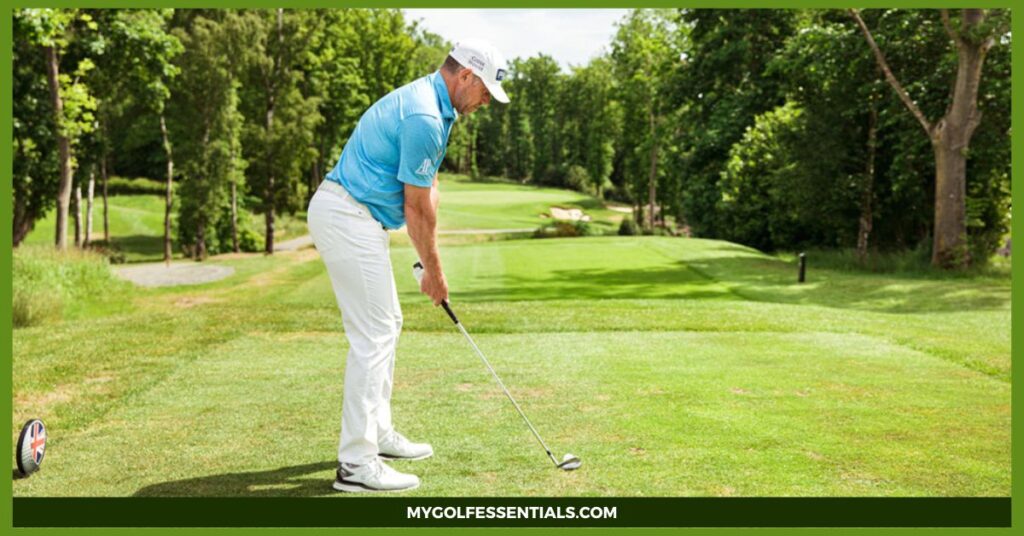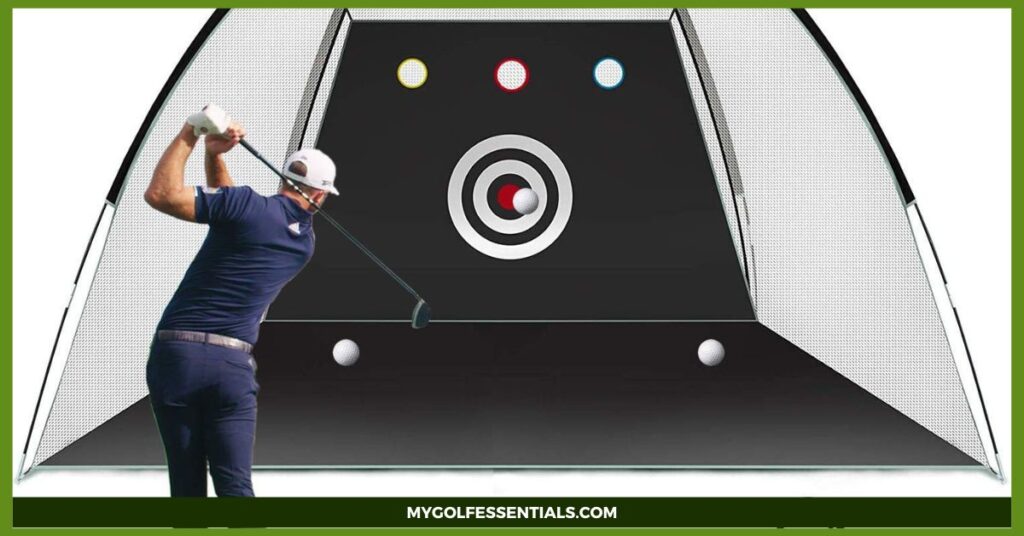
Getting your golf shots lined up correctly is key to playing better and more consistent golf. Whether you’re new to the game or have been playing for years, knowing how to align your shots can make a big difference. It’s because we all know that proper alignment sets the foundation for every shot, influencing everything from accuracy to distance.
In this comprehensive guide for 2024, we’ll walk you through the essential tips and techniques to help you line up your golf shots with confidence and precision. Therefore we invite you to keep reading to learn how a few simple adjustments can make all the difference in your performance on the course.
So, without further ado, let’s get started…
What Is Meant By Golf Alignment?
Golf alignment refers to the process of positioning your body(particularly your feet, hips, and shoulders) in the correct orientation to the target line before you take a shot. Furthermore, the use of proper alignment methodology has become crucial in golf because it ensures that your body is aimed correctly at the target. Thus allowing you to swing the club in the intended direction.
Here are the key elements of golf alignment:
- Feet Alignment: Your feet should be positioned parallel to the target line (the imaginary line running from your ball to the target). This means that your toes should be pointing straight ahead, not toward the ball or away from it.
- Hips Alignment: Your hips should also be parallel to the target line. A misalignment here can lead to an incorrect swing path, causing the ball to veer off course.
- Shoulders Alignment: Your shoulders should be parallel to the target line as well. If your shoulders are open (pointing left for right-handed golfers) or closed (pointing right), it can affect the direction of your swing and, consequently, the ball’s flight.
- Clubface Alignment: The clubface should be square to the target line. Even if your body is aligned correctly, the ball will not travel in the desired direction if the clubface is open or closed.
Proper alignment helps in achieving consistent ball flight and improving accuracy. Furthermore, the golfers often use alignment aids, such as alignment sticks or markers on the driving range, to practice and perfect their alignment before taking shots on the course.
What Tools Can I Use To Aid In Gaining Correct Golf Alignment
Achieving proper alignment in golf is essential for improving accuracy and consistency. Fortunately, several tools are available in the market that can help you to refine your golf alignment skills. Among them, two of the most effective tools are alignment sticks and golf swing alignment braces.
Let’s explore each of these tools in detail in the coming sections.
- Golf Alignment Sticks
Golf alignment sticks are long, lightweight rods typically made of fiberglass or plastic. They are often used during practice sessions to help golfers visualize and maintain proper alignment. By placing the sticks on the ground, you can create a target line and ensure your body is aligned parallel to that line.
Benefits of Using Alignment Sticks
- Visual Reference: Alignment sticks provide a clear visual guide for golfers, making it easier to see whether their body and clubface are aligned correctly.
- Versatility: They can be used for various drills, including stance alignment, swing path, and even putting alignment.
- Immediate Feedback: Golfers can quickly assess their alignment and make necessary adjustments, leading to improved performance on the course.
- Portable and Affordable: Alignment sticks are lightweight, easy to carry, and typically inexpensive, making them accessible for golfers of all levels.
- Golf Swing Alignment Brace
A golf swing alignment brace is a wearable tool designed to help golfers maintain proper body alignment throughout their swing. The brace typically wraps around the torso and connects to the arms, providing physical feedback on the correct positioning of the body during the swing. It encourages a stable posture and helps prevent common alignment errors.
Benefits of Using Golf Swing Alignment Brace
- Physical Support: The brace offers physical guidance, helping golfers feel the correct body positioning during their swing, which can be particularly beneficial for those who struggle with alignment.
- Reinforcement of Good Habits: By wearing the brace during practice, golfers can reinforce proper alignment habits, making it easier to replicate them during actual play.
- Targeted Correction: The brace can help address specific alignment issues, such as an open or closed stance, allowing golfers to focus on improving their overall swing mechanics.
Comparison with Alignment Sticks
- Functionality: While alignment sticks provide a visual reference for alignment, the golf swing alignment brace offers physical support and feedback, helping golfers feel the correct positioning.
- Usage Context: Alignment sticks are primarily used during practice sessions to set up alignment drills, whereas the alignment brace can be worn during both practice and play to reinforce proper alignment habits.
- Skill Level: Alignment sticks are suitable for all golfers, from beginners to advanced players, while the alignment brace may be particularly beneficial for those looking to correct specific alignment issues or improve their swing mechanics.
Incorporating these tools into your practice routine can significantly enhance your alignment skills, leading to more accurate shots and a better overall golf game. Whether you choose alignment sticks for their versatility or a swing alignment brace for its physical support, both tools can play a vital role in your development as a golfer.
Basic Golf Alignment Techniques For 2024
Proper alignment is a fundamental aspect of executing a successful golf shot. Here, we will cover essential techniques for setting up for a shot, the importance of using alignment sticks, and practical drills to enhance your alignment skills.
How to Play a Golf Shot With Correct Alignment
Here is a 7 step-by-step guide that you can follow to play a golf shot with the correct alignment.
- Stand Behind the Ball:
Begin by positioning yourself about five feet behind the ball. This perspective allows you to visualize a straight line to your target.
- Align Your Target Line:
Pick a target in the distance and trace an imaginary line from your ball to that target. Use this line to set up your alignment sticks or clubs on the ground, creating a parallel line for your stance.
- Position Your Feet:
Your feet should be shoulder-width apart, with your left toe angled slightly outward (for right-handed golfers). Ensure your feet are parallel to the target line, which should be slightly left of your intended target.
- Align Your Hips and Shoulders:
Your hips and shoulders should also be parallel to the target line. Avoid aligning them directly at the target, as this can lead to a closed stance. Instead, keep them slightly left of the target line.
- Aim the Clubface Correctly:
Before taking your stance, ensure that the clubface is square to the target line. The leading edge of the club should be perpendicular to the imaginary line you created from the ball to the target.
Why Is It Important to Aim The Clubface Correctly?
The clubface is the most important factor in determining the initial direction of the golf ball’s flight. Aiming the clubface correctly is crucial for hitting straight shots and avoiding hooks or slices3.
At address, the leading edge of the clubface should be perpendicular to your target line. This is known as a “square” clubface position. During your swing, your goal is to return the clubface to this square position at impact.
If the clubface is open (pointing right of the target for right-handers) at impact, the ball will start right of the target and potentially slice. A closed clubface (pointing left) can result in a pull or hook.
To ensure a square clubface at impact, focus on a consistent grip and an aligned setup. Regular practice with alignment aids or mirror work can help engrain the correct clubface alignment.
Remember, your clubface has the greatest influence on the initial direction of the ball. Setting it properly behind the ball is crucial for hitting straight shots. Take the time to aim the clubface correctly before each shot.
- Ball Position:
The ball position will vary depending on the club you are using. For longer clubs (like a driver), the ball should be more forward in your stance, closer to your front foot. For shorter irons, the ball should be centered or slightly back in your stance.
Remember that you need to ensure the ball position remains consistent for each type of shot to maintain consistent alignment and swing mechanics.
- Alignment Routine:
- Step 1: Line Up the Clubface: Begin by aligning the clubface to the target while standing behind the ball.
- Step 2: Align Your Body: After the clubface is set, step into your stance, ensuring your feet, hips, and shoulders are aligned parallel to the target line.
- Step 3: Final Check: Before taking the shot, do a quick mental check of your alignment(feet, hips, shoulders, and clubface) to make sure everything is aimed as intended.
How to Train a Golf Shot Using Alignment Sticks,
Here is a Step-by-Step Guide on Setting Up Alignment Sticks:
- Select Your Target: Identify a target in the distance and visualize a line from your ball to that target.
- Place the Alignment Sticks: Set one alignment stick on the ground along your target line and another parallel to it, indicating your stance line.
- Check Your Setup: Stand behind the ball and ensure that your feet, hips, and shoulders are aligned with the stance stick, while the clubface is aimed at the target stick.
- Take Your Stance: Step up to the ball, ensuring that your body is positioned correctly relative to the alignment sticks.
Furthermore,
Here Are Some Basic Drills to Practice Alignment:
- Target Line Drill: Regularly practice hitting shots while using alignment sticks to reinforce the correct setup. This drill helps develop muscle memory for proper alignment.
- Mirror Drill: Use a mirror to check your alignment. Stand in front of it and practice your stance while ensuring your shoulders and hips are parallel to the target line.
- Buddy Check: Have a friend observe your alignment from behind as you set up. They can provide feedback on whether your body is aligned correctly.
You can significantly improve your setup for each shot by consistently practicing these alignment techniques and drills, leading to greater accuracy and consistency on the course.
Advanced Alignment Drills To Enhance Your Golf Game
Improving your alignment is essential for enhancing your golf game. Advanced alignment drills can help you develop muscle memory and consistency in your setup.
Here are two categories of drills: Alignment Stick Drills and Swing Plane and Path Drills.
- Alignment Stick Drills
Here is a detailed explanation of various drills that involve alignment sticks.
- Train Tracks Drill
To get this to work, you need to place two alignment sticks on the ground, parallel to each other and facing your target, about a foot apart. Position the ball a few inches behind the back stick.
Here, the objective is to keep your clubhead within the “tracks” created by the sticks throughout your swing. This helps train you to maintain a square clubface, leading to more accurate shots.
- Ball Position Alignment Stick Drill
For this to work, you can use one alignment stick to represent your target line and another to indicate where your back foot should be based on the club you’re using.
Here, the objective is to adjust the back foot stick according to the club (e.g., center for short irons, front heel for drivers). This drill encourages correct ball placement for various shots.
- Shot Shape Alignment Stick Drill
To get this to work, you need to set two rods 2-3 feet apart in front of you.
Here, the objective is to hit the ball between the poles. For advanced players, position one stick to encourage a draw or fade by starting the ball on one side and curving it to the other.
Tips for Incorporating These Drills into Practice Sessions
- Consistency: Dedicate a portion of each practice session to alignment drills to reinforce proper setup.
- Focus on Feedback: Use a friend or coach to provide feedback on your alignment as you practice these drills.
- Mix It Up: Alternate between different drills to keep your practice sessions engaging and cover various aspects of alignment.
- Swing Plane and Path Drills
Here are some general techniques you can use to maintain a consistent swing plane:
- Swing Plane Drill
For this to work, you can use an alignment stick placed in the ground at an angle that matches your desired swing plane.
Here, the objective is to practice swinging the club along the stick, ensuring your clubhead follows the correct path throughout your swing.
- Wall Drill
For this to work, you can simply stand with your back against a wall and practice your swing without hitting the wall.
Here, the objective is to help you maintain a consistent swing plane by restricting your movement and ensuring your arms stay close to your body.
Here are some general drills to improve swing path accuracy:
- Path Drill with Alignment Sticks
For this to work, you can simply place one alignment stick on the ground along your target line and another stick to create a gate for your clubhead to pass through during the swing.
Here, the objective is to practice swinging through the gate created by the sticks, ensuring your clubhead follows the correct path.
- Tee Drill
For this to work, you can simply place a tee in the ground just outside your target line.
Here, the objective is to practice hitting the ball without touching the tee, promoting an inside-out swing path.
Incorporating these advanced alignment drills into your practice routine will enhance your alignment skills, leading to more consistent swings and improved overall performance on the golf course. Regular practice will help solidify these techniques, making them second nature during your rounds.
Practicing for Consistency
Achieving consistency in golf requires deliberate practice and effective use of alignment tools. For that, incorporating alignment sticks into your routine and understanding how to adjust based on feedback can significantly enhance your performance on the course.
Routine Practice with Alignment Tools
How to Integrate Alignment Sticks into Regular Practice
- Setup for Every Session: Begin each practice session by setting up alignment sticks. Place one stick along your target line and another parallel to it to guide your stance. This setup will help you visualize your alignment before every shot.
- Incorporate Various Drills: Use alignment sticks for different drills, such as the Train Tracks drill or the Ball Position drill. This integration allows you to focus on both your alignment and swing mechanics simultaneously.
- Practice Different Shots: Use alignment sticks for various types of shots, including drives, approach shots, and putts. For putting, place a stick on the ground to align your clubface and body position, ensuring you’re aimed correctly at your target.
Suggestions for Practice Routines Focusing on Alignment
- Warm-Up Routine: Start with a few minutes of alignment stick drills to reinforce your setup before hitting balls. Focus on ensuring your feet, hips, and shoulders are aligned with the sticks.
- Target Practice: Choose a target on the range and practice hitting shots while ensuring your alignment sticks are properly set. This can help you develop a consistent aim.
- Feedback Sessions: After hitting a series of shots, evaluate your performance. Use the alignment sticks to identify any misalignments in your setup or swing path.
Importance of Visual Feedback in Improving Alignment
Visual feedback is crucial for improving your alignment. Alignment sticks provide a clear reference for your body positioning and clubface alignment, allowing you to see where adjustments are needed.
Furthermore, this immediate visual cue helps reinforce proper habits and correct mistakes in real time.
How to Adjust Based on Practice Outcomes
- Evaluate Your Shots: After practicing, assess the direction and consistency of your shots. If you notice a pattern of misses to one side, it may indicate an alignment issue.
- Make Incremental Adjustments: Based on your observations, make small adjustments to your stance or clubface alignment. For example, if you’re consistently pulling shots to the left, try adjusting your body alignment slightly to the right.
- Record Your Progress: Keep a practice journal to track your alignment drills and outcomes. Documenting your progress can help you identify trends and make informed adjustments over time.
By integrating alignment sticks into your practice routine and utilizing visual feedback effectively, you can enhance your consistency and accuracy on the golf course. Regular practice and thoughtful adjustments will lead to significant improvements in your overall game.
9 Common Alignment Mistakes That Golfers Make While Playing Golf
Golfers often struggle with alignment, leading to inconsistent shots and frustration on the course. Among them, here are some of the most frequent alignment errors golfers make while playing:
- Feet Pointing Toward the Target:
Many golfers mistakenly point their feet directly at the target rather than parallel to the target line. This can cause a misalignment where the body is actually aimed left (for right-handed golfers) or right (for left-handed golfers) of the target, leading to slices or hooks.
- Solution: Ensure that your feet are aligned parallel to the target line.
- Drill: Place an alignment stick on the ground along the target line and another parallel to it for your stance. Practice setting up with your feet, knees, and hips aligned with the stance stick.
- Misaligned Shoulders: Open or Closed Shoulders
When the shoulders are aligned open to the target (pointing left for right-handed golfers), it often causes an out-to-in swing path. This can result in pulls or slices, where the ball starts left and curves further left.
If the shoulders are aligned too far to the right (closed for right-handed golfers), the golfer might swing too much from the inside, leading to pushes or hooks, where the ball starts right and curves left.
- Solution: Your shoulders should be aligned slightly left of the target (for right-handed golfers) to promote a proper swing path.
- Drill: Stand with a club across your shoulders to check alignment. Adjust your shoulders until they are parallel to the target line.
- Incorrect Hip Alignment:
Misalignment of the hips, either open or closed relative to the target line, can throw off the swing path. Open hips can cause an over-the-top swing, while closed hips can lead to an inside-out path, both resulting in wayward shots.
- Solution: Ensure your hips are parallel to your feet and aligned with the target line.
- Drill: Use a friend to hold a club across your hips while you set up. Step away and check where the club points to ensure proper alignment.
- Clubface Misalignment:
A common mistake is aligning the clubface either open or closed relative to the target. Even if the body is correctly aligned, a misaligned clubface can cause the ball to start off-line and miss the target.
- Solution: Always align the clubface first before addressing the ball.
- Drill: Stand behind the ball and visualize a line to your target. Set the clubface square to this line before positioning your body.
- Poor Eye Line:
Sometimes, golfers align their eyes incorrectly relative to the ball and target line. This can create an illusion that the body is aligned correctly when it’s not, leading to a misaligned shot.
- Solution: Ensure your head and eyes are parallel to the target line.
- Drill: Practice looking at a target a few feet in front of the ball while aligning your head and eyes. Use visual markers on the ground to help guide your alignment.
- Not Checking Alignment Regularly:
Golfers often fail to check their alignment consistently. Over time, even a small deviation can become a big problem, leading to ingrained habits that are difficult to correct.
- Using the Wrong Part of the Body for Alignment:
Some golfers focus on aligning their upper body rather than their lower body, or vice versa. For consistent shots, it’s essential that all parts of the body (feet, hips, and shoulders) are aligned parallel to the target line.
- Not Accounting for the Lie of the Ball:
On uneven terrain, golfers often forget to adjust their alignment to account for the slope. For example, on a sidehill lie, the ball’s flight will naturally curve with the slope, so adjustments in alignment are necessary to compensate.
- Rushing the Setup:
In a hurry to take the shot, golfers may neglect to properly align themselves. Taking time to set up correctly is crucial for consistent, accurate shots.
Furthermore,
In order to correct these alignment mistakes you need to keep up with regular practice.
For that, you can often use alignment aids like sticks. Orelse, you can use visual cues during practice to ensure the body and club are aligned correctly before every shot.
Final Thoughts
Mastering golf alignment is a fundamental aspect of improving your game. Proper alignment not only ensures that your body is positioned correctly for each shot but also enhances your accuracy, consistency, and overall performance on the course.
By incorporating the techniques and tools discussed in this guide(such as alignment sticks, swing alignment braces, and various drills) you can develop a strong foundation for every shot you take.
Whether you’re a beginner or an experienced golfer, these alignment practices will help you build confidence in your setup, leading to more consistent and successful rounds of golf.
Remember, practice makes perfect, so dedicate time to refining your alignment skills and watch your game improve in 2024.
FAQs
1. How does poor alignment affect a golf swing?
Poor alignment can cause your swing path to deviate from the target line, leading to inconsistent shots that often result in hooks or slices. Misalignment forces golfers to compensate in their swing, which can result in further issues and loss of accuracy.
2. What are the key elements of proper golf alignment?
Proper alignment involves aligning your clubface with the target line, positioning your feet parallel to that line, and ensuring your shoulders are square. These three components—clubface, feet, and shoulders—are critical for maintaining a consistent and powerful swing.
3. How can I practice lining up my golf shots?
The best way to practice aligning your golf shots is by using alignment sticks. Place a stick on the ground parallel to your target line and align your clubface, feet, and shoulders with it. Regular practice with alignment aids will help build muscle memory for consistent shots.
4. How do I align my feet when addressing the golf ball?
To align your feet correctly, first set your clubface along the target line. Then, align your trail foot with the leading edge of your clubhead, and position your lead foot to match it. Your feet should be parallel to the target line to ensure a square stance.
5. How do I align my shoulders correctly?
To align your shoulders correctly, stand with a club or alignment stick across your chest and ensure it runs parallel to your target line. Misaligned shoulders can cause unwanted swing paths, leading to slices or hooks.



